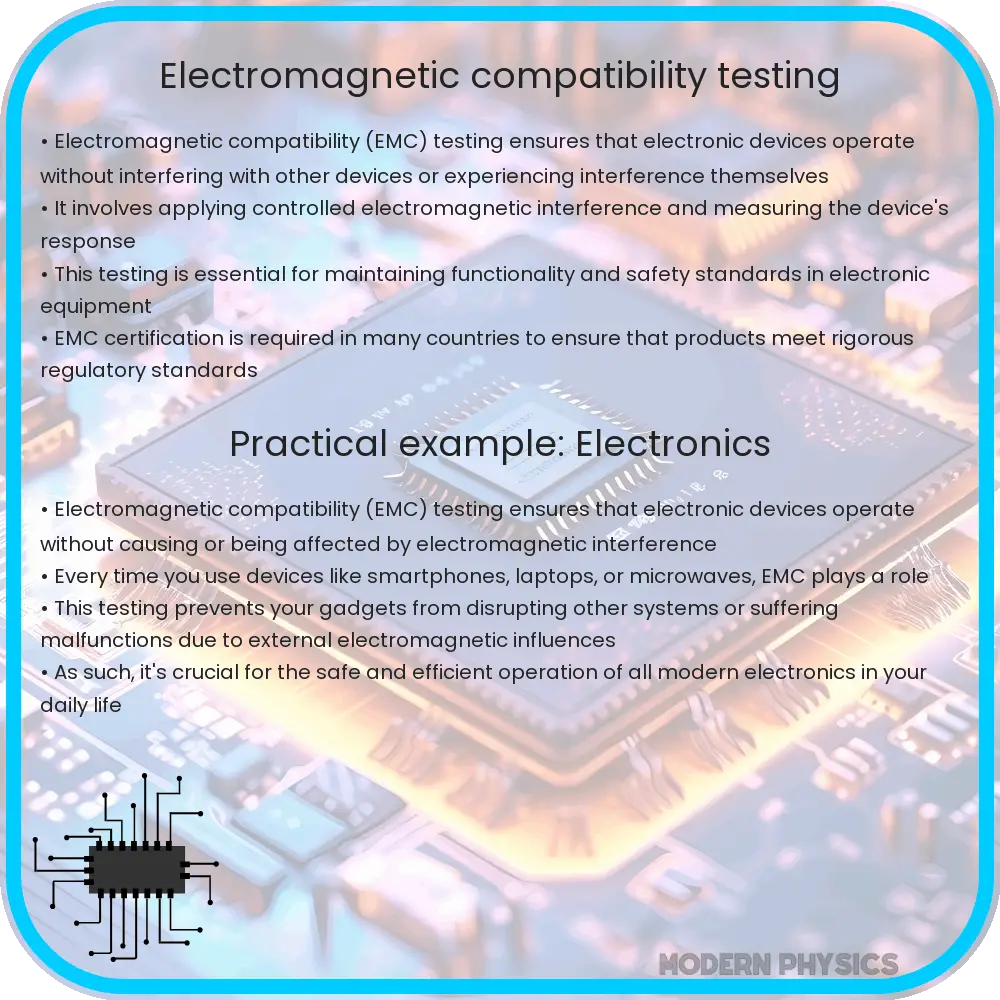Electromagnetic Compatibility (EMC) Testing ensures electronic devices operate without causing or suffering from electromagnetic interference.

Understanding Electromagnetic Compatibility Testing
Electromagnetic Compatibility (EMC) Testing is crucial for ensuring that electronic devices operate as intended without causing or being susceptible to electromagnetic interference (EMI). This kind of testing is vital for maintaining the reliability, safety, and compliance of electronic products in an increasingly electronic-based world. In this article, we’ll explore what EMC testing involves, why it’s necessary, and how it ensures both accuracy and compliance in electronic devices.
What is Electromagnetic Compatibility?
Electromagnetic Compatibility (EMC) refers to the ability of electrical equipment to function satisfactorily in its electromagnetic environment without introducing intolerable electromagnetic disturbance to anything in that environment. There are two main aspects associated with EMC:
- Emission: The amount of electromagnetic energy an electronic device releases. Devices must have limited emissions to prevent disruption to other devices.
- Immunity: A device’s ability to operate correctly even when exposed to specific levels of electromagnetic disturbances.
The Need for EMC Testing
As our reliance on electronic devices grows, the potential for electromagnetic interference increases. EMC testing is therefore essential to ensure that new devices can coexist within their intended environments without causing or falling victim to interference. This testing is not just a technical requirement but also a legal one in many parts of the world, designed to ensure safety and functional accuracy.
Components of EMC Testing
EMC testing involves various tests to measure both emissions and immunity of a device. Here are some of the key tests conducted:
- Conducted Emission Test: Measures the electromagnetic energy that a device generates along its power or signal lines.
- Radiated Emission Test: Measures the electromagnetic energy radiated into the surrounding environment from a device.
- Electrostatic Discharge (ESD) Test: Assesses a device’s ability to withstand electrostatic discharges which can occur when handling electronics.
- Surge Immunity Test: Evaluates a device’s capability to withstand surges (like those from lightning or power transitions).
- Radio Frequency (RF) Immunity Test: Determines how external radio frequency fields affect the device.
Each of these tests helps engineers identify and mitigate potential problems, ensuring that the device is both safe and compliant with international standards such as those set by the International Electrotechnical Commission (IEC) and the Institute of Electrical and Electronics Engineers (IEEE).
Global Standards and Compliance
Adhering to international and regional standards is fundamental in EMC testing. Different countries and regions have specific requirements and standards that products must meet before they’re allowed on the market. For instance, the European Union has strict EMC directives that all electronic products must comply with to be sold within the EU. Similarly, the United States follows standards set by the Federal Communications Commission (FCC).
This global landscape of standards necessitates comprehensive and accurate EMC testing to ensure products achieve universal market access. Manufacturers must thoroughly test and certify their products for EMC to avoid legal issues and maintain product reliability and consumer trust.
EMC Testing Facilities
Due to the complex nature of EMC testing, it typically takes place in specialized test labs equipped with advanced testing apparatus. These facilities must be meticulously designed to prevent external electromagnetic disturbances from affecting the accuracy of the tests. Commonly, these facilities include:
- Anechoic chambers: Shielded rooms designed to completely absorb reflections of sound or electromagnetic waves.
- Open area test sites: Outdoor areas used primarily for radiated emission testing.
- Shielded rooms: Enclosures used to prevent external electromagnetic fields from interfering with the testing process.
In these controlled environments, devices undergo rigorous testing to ensure they meet the necessary EMC standards and can perform reliably in their intended operational environments. This testing not only corroborates compliance with legal requirements but also contributes significantly to the product’s quality assurance.
Challenges in EMC Testing
EMC Testing, while systematic, faces several challenges that can impact the accuracy and efficacy of the tests. One significant challenge is the ever-evolving nature of technology. As new devices and technologies emerge, testing protocols must adapt to address new types of electromagnetic emissions and susceptibilities. Moreover, the miniaturization of electronics increases the difficulty in isolating and measuring electromagnetic emissions accurately.
Another challenge is the environmental factor. External electromagnetic disturbances, such as those from radio transmitters or cellular towers, can affect the accuracy of testing if not properly shielded against in the testing facilities. Furthermore, the rapid proliferation of wireless devices increases the density of electromagnetic fields, which complicates the testing environment.
The Future of EMC Testing
The continuous advancements in electronic technology and the increasing reliance on wireless communication suggest that EMC testing will only grow in importance. Future directions for EMC testing may involve more sophisticated simulation tools to predict EMC performance before physical prototypes are built. Additionally, there might be an increased focus on developing standards that address the challenges posed by emerging technologies such as IoT devices and 5G networks.
Increased collaboration between governments, standardization bodies, and manufacturers will be crucial to developing effective global EMC standards. These standards will need to be adaptable and dynamic to cope with technological advancements and the increasing complexity of electronic environments.
Conclusion
Electromagnetic Compatibility Testing is a critical component in the development and deployment of electronic devices. It ensures that products are safe, reliable, and compliant with international regulations, protecting both the device and its user from potential harm due to electromagnetic interference. While challenges such as technological advancements and environmental factors add complexity to EMC testing, the field continues to evolve, promising more sophisticated testing methodologies and standards. As we become increasingly dependent on electronic devices in our everyday lives, the role of EMC testing in facilitating seamless and safe interactions with technology cannot be overstated. Through rigorous testing protocols and global cooperation in standard setting, EMC testing helps pave the way for technological innovation and assurance in product performance and safety.
